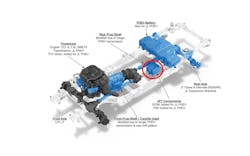The collision repair industry is dealing with some of the most rapid changes in technology in recent history, thanks to the move toward total vehicle electrification. This month, ABRN will discuss EVSE. Do you have the knowledge and tools to deal with EVSE in your collision shop? If you’re even wondering what “EVSE” stands for...welcome to the future!
EVSE and NEMA - Acronyms to remember
According to the National Electrical Manufacturer’s Association (NEMA), “Electric vehicle supply equipment (EVSE) supplies electricity to charge an electric vehicle (EV). Commonly called charging stations or charging docks, they provide electric power to the vehicle and use that to recharge the vehicle's batteries. EVSE systems include electrical conductors, related equipment, software, and communications protocols that deliver energy efficiently and safely to the vehicle.”
Onboard HV battery chargers
The charger on any plug-in hybrid electric vehicle (PHEV) or battery electric vehicle (BEV) is NOT the cord that comes with the vehicle or hangs on the wall of a public parking garage. It is part of the PHEV or BEV. Think of your smart phone. The charge cable going to your phone simply carries the 5 volts the phone needs to charge its internal battery. Once that 5 volts of DC power is made available to the plug on your phone, a battery management system (BMS) inside the phone makes sure the phone is properly charged and kept from overheating. Regardless if the vehicle in your collision shop is a Tesla Model S (BEV) or Jeep Wrangler 4XE (PHEV), that “charger” is a component on the vehicle that you will be replacing when damaged in a collision. (fig. 1) On the first-generation Chevy Volt (PHEV), for example, the on-board charger (OBC) is located in the right front fender area. In a frontal collision, it’s likely that module will need to be inspected to ensure coolant lines are in place and not leaking. You’ll also need to make sure there are no compromised orange / HV cables or related DTCs stored. On the second generation of Chevy Volts, GM moved the onboard charging module into the trunk area next to the DC-DC converter.
HV battery charger terms will vary by OEM:
- Chevy Volt (PHEV) Onboard charging module
- Chevy Bolt (BEV) Onboard charging module
- Ford Mustang Mach E (BEV) SOBDM (Secondary on-board diagnostic module)
- Jeep Wrangler 4XE (PHEV) IDCM (Integrated dual charging module (fig. 1)
Facts about “the plug” every collision repair specialist should know
BEVs (battery electric vehicles) and PHEVs are equipped with a charge receptacle to plug the vehicle into. Obviously, the PHEV has an internal combustion engine, (ICE), so you’re typically not stranded if the charge cable “doesn’t charge the HV battery.” Though the overall fuel economy of a PHEV will be adversely affected if it doesn’t get a high-voltage battery charged from EVSE, this type of electrified vehicle is designed to travel long distances as a full hybrid when its electric-only range has been depleted. Gasoline can get you home! On the other hand, a BEV could leave you with little or no range when there’s an EVSE “plug problem.” That means your customer (or you) might get stranded after the BEV is repaired and returned to service.
Charge cables and Levels
Mild hybrids (MHEV) and Full hybrids (HEVs) don’t require an external charge cable / vehicle plug. Plug-in hybrid electric vehicles (PHEVs) typically use a medium-size, liquid-cooled Li-Ion battery back that can be charged with a Level 1 (120-volt) or Level 2 (240-volt) charge cables to give 20-50 miles of EV range before the engine starts to make it a regular hybrid again. Battery electric vehicles (BEVs) MUST have large Li-Ion battery packs that can be charged with a Level 1 (typically 2-days) or Level 2 (typically one-day) or a DC fast charger (i.e., Electrify America, Tesla Supercharger, etc.) in under an hour. In addition to the five pins of a J1772 plug, DC fast chargers use two additional dedicated pins at the BEV’s CCS (combined charging system) charge plug (non-Tesla). On Tesla models using the NACS (North American Charging Standard), the 5-pin plug has two of its pins that normally connect to 120-volts / 240-volts of AC power into the on-board charging module, no go directly into the battery pack. With any vehicle’s Level 1 or Level 2 AC charge cable, the AC has to be rectified into DC and converted into a higher voltage (340-volts up to 400-volts) of DC to charge the vehicle’s battery pack.
EVSE – Case study: Level 1 charge cables, extension cords and DJs
Anyone diagnosing electrical problems needs to know what a voltage drop is. Recently, I was displaying a Ford Mustang Mach E (BEV) at an aftermarket parts customer’s electric vehicle expo. I wanted to charge the vehicle to demonstrate a working Level 1 EVSE cable. I connected the charge cable to the car and discovered the closest 15-amp 120-volt receptacle was over 50 feet away. The Level 1 Ford cable was too short, so the folks at that location loaned me a 75-foot outdoor extension cord. It was a well-worn 14-gauge (14-3) extension cord, but at least the ground terminal was in place.
The charge cable’s status LEDs and the vehicle’s EVSE charge port “halo” lights displayed their normal “all is well” as the Mach E took the “slow charge” of 14 amps (max). I then plugged in my GFCI outlet tester (fig. 2) to the extension cord powering the Level 1 charge cable and observed the proper LEDs on that tester along with the word “Correct” and “119 VAC” on its display. All was well until the DJ showed up to provide entertainment for the event. The DJ plugged into the same multi-receptacle GFCI outlet that I was plugged into. The Level 1 cable (with extension cord) began flashing its LEDs, indicating there was a problem with the power source. I checked the power source again with the receptacle tester, and the power was still “correct” (no loss of ground or other polarity problems), but the VAC was now down to 115. That’s only a 4-volt drop, hardly what I’d call a “brownout.” Could there have been some transients caused by the DJ’s (very loud) equipment? I never really determined the root cause – but I did learn a simple lesson with EVSE. You might not charge an EV if the EVSE is not correct! Manufacturers strongly discourage the use of extension cords for PHEV / EV charging. Most extension cords will (at least) cause enough voltage drop to a 12-15 amp Level 1 charger to cause a potential charging problem. Some extension cords are so undersized that the excessive resistance creates an overheating condition of the cord, wall plug, and charger.
Cautions on charging PHEVs and BEVs
At the conclusion of any collision repair, consider charging the battery pack to verify that the vehicle’s charge cable connection is functional, the OBC is working, and the battery pack can take a charge (the EV range increases). You’ll need an undamaged Level 1 charge cable (the one that came with the vehicle [fig. 3] or a quality aftermarket charge cable) and properly wired AC power receptacle. You might consider an outdoor location for charging. Any collision damage to a HEV, PHEV or BEV is a potential “vehicle modification" that may have “changed” the built-in high voltage safety systems on the vehicle. Since most (if not all) PHEVs and BEVs use Li-Ion battery packs, the very nature of this battery chemistry can lead to an increased risk for a thermal runaway condition (AKA a fire). This could lead to a devastating situation for any collision shop.
Therefore, it is recommended by most OEMs and fire safety experts that damaged PHEVs and BEVs be kept outside and away from structures and other vehicles prior to damage assessment. Many mechanical repair shop owners are leery of storing BEVs inside their shops overnight for this reason. In my personal opinion, this could be a “better safe than sorry” approach, but at the very least, do NOT connect a Level 1 or Level 2 charger to any collision-damaged vehicle inside your shop and NEVER leave a customer’s PHEV / BEV charging unattended. Most of us in the business (mechanical or collision repair) know that overnight battery charges are not a good idea on 12-volt batteries. When the voltage of the battery goes up to 340 – 400 volts, the potential hazards multiply, as well!




